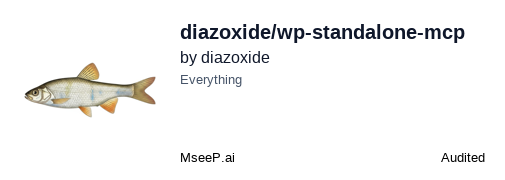Enables management of WordPress sites through the WordPress REST API, providing tools for handling posts, pages, users, media, comments, plugins, themes, and other WordPress resources. Supports multi-site configurations with dynamic discovery of REST API endpoints.

WordPress Standalone MCP Server
A powerful Model Context Protocol (MCP) server that provides seamless integration between AI assistants and WordPress sites through the WordPress REST API. This server automatically discovers and creates individual tools for each WordPress REST API endpoint, enabling natural language WordPress management.
✨ Features
🔄 Dynamic Tool Generation: Automatically creates individual tools for each discovered WordPress REST API endpoint
🌐 Multi-Site Support: Manage multiple WordPress sites simultaneously from a single configuration
🔒 Secure Authentication: Uses WordPress Application Passwords for secure API access
🎯 Smart Tool Filtering: Include/exclude specific tools using exact match or regex patterns
📊 Comprehensive Coverage: Support for posts, pages, users, media, comments, plugins, themes, and more
🚀 Zero Configuration Discovery: Automatically maps all available endpoints without manual setup
⚡ High Performance: Efficient endpoint discovery and request handling
🛡️ Error Handling: Graceful error handling with detailed diagnostic messages
🚀 Quick Start
Installation
Basic Configuration
Create a WordPress Application Password:
Go to your WordPress admin → Users → Profile
Scroll to "Application Passwords" section
Create a new application password
Copy the generated password
Create configuration file (
wp-sites.json):Configure Claude Desktop (
claude_desktop_config.json):Restart Claude Desktop and start managing your WordPress sites!
Tools Reference
Dynamic Endpoint Tools
When the server starts, it automatically discovers all available WordPress REST API endpoints and creates individual tools for each endpoint/method combination. Tool names follow the pattern: [site]_[method]_[resource] or [site]_[method]_[resource]_id for ID-specific endpoints.
Examples:
myblog_get_v2_posts- List all postsmyblog_get_v2_posts_id- Get a specific post by IDmyblog_post_v2_posts- Create a new postmyblog_put_v2_posts_id- Update a specific postmyblog_delete_v2_posts_id- Delete a specific post
wp_discover_endpoints
Re-discovers all available REST API endpoints on a WordPress site.
Arguments:
Returns: List of available endpoints with their methods and namespaces.
🔧 Configuration
Environment Variables
WP_SITES_PATH: Path to your WordPress sites configuration fileWP_SITES: Direct JSON configuration (alternative to file)
Site Configuration Schema
Getting an Application Password
Log in to your WordPress admin dashboard
Go to Users → Profile
Scroll to the "Application Passwords" section
Enter a name for the application (e.g., "MCP Server")
Click "Add New Application Password"
Copy the generated password (you won't be able to see it again)
Note: Application Passwords require WordPress 5.6 or later and HTTPS.
Advanced Tool Filtering
Control which WordPress operations are available by filtering tools:
Filter Rules:
include: Only specified tools are exposed (whitelist)exclude: Specified tools are hidden (blacklist)includetakes precedence overexcludeSupports exact matches and regex patterns (wrap in
/pattern/)
🛠️ Generated Tools
The server automatically creates tools following this naming convention:
Pattern:
[site]_[method]_[resource]or[site]_[method]_[resource]_idExamples:
myblog_get_v2_posts- List all postsmyblog_get_v2_posts_id- Get specific post by IDmyblog_post_v2_posts- Create new postmyblog_put_v2_posts_id- Update specific postmyblog_delete_v2_posts_id- Delete specific postmyblog_get_v2_media- List media filesmyblog_get_v2_users- List users
Discovery Tool
wp_discover_endpoints- Re-discover available endpoints for a site
💡 Usage Examples
Once configured, interact with your WordPress sites using natural language:
List and Query Posts
Create and Edit Content
Manage Comments
Plugin Management
Content Management
Media Management
User Management
Site Analysis
🏗️ Architecture
🔒 Security
Application Passwords: Uses WordPress's secure application password system
HTTPS Required: All connections must use HTTPS
Configuration Security: Keep configuration files outside web-accessible directories
Principle of Least Privilege: Use accounts with minimal required permissions
No Credential Storage: Credentials are only used for API authentication
🐛 Troubleshooting
Common Issues
"Site not configured" error
Verify site alias in configuration matches usage
Check configuration file path and format
"Authentication failed" error
Verify application password is correct
Ensure user account has necessary permissions
Check if site URL is accessible
"No tools discovered" error
Verify WordPress site has REST API enabled
Check if site URL includes
/wp-jsonaccessibilityReview any security plugins blocking REST API
Debug Mode
Set DEBUG=wp-mcp environment variable for detailed logging:
📋 Requirements
WordPress: 5.6+ (for Application Passwords)
Node.js: 16+
HTTPS: Required for Application Passwords
REST API: Must be enabled (default in WordPress)
🤝 Contributing
We welcome contributions! Please see our Contributing Guide for details.
Fork the repository
Create a feature branch
Make your changes
Add tests if applicable
Submit a pull request
📄 License
MIT License - see LICENSE file for details.
🔗 Links
Repository: https://github.com/diazoxide/wp-standalone-mcp
Issues: https://github.com/diazoxide/wp-standalone-mcp/issues
WordPress REST API: https://developer.wordpress.org/rest-api/
Model Context Protocol: https://modelcontextprotocol.io/
🙏 Acknowledgments
WordPress REST API team for the comprehensive API
Anthropic for the Model Context Protocol specification
The open-source community for continuous support and feedback
Made with ❤️ for the WordPress and AI community
This server cannot be installed
remote-capable server
The server can be hosted and run remotely because it primarily relies on remote services or has no dependency on the local environment.
A Model Context Protocol server that automatically discovers WordPress REST API endpoints and creates individual tools for each endpoint, enabling natural language management of WordPress sites.
Related MCP Servers
- AsecurityFlicenseAqualityA WordPress plugin that implements the Model Context Protocol to enable AI models and applications to interact with WordPress sites in a structured and secure way.Last updated -57576
- -securityAlicense-qualityImplements a Model Context Protocol server for WordPress that enhances VS Code with WordPress-specific intelligence, including database integration, code completion, and documentation.Last updated -3062MIT License
- -securityFlicense-qualityA server implementation of the Model Context Protocol (MCP) that provides REST API endpoints for managing and interacting with MCP resources.Last updated -
- -securityAlicense-qualityA Model Context Protocol server that enables AI assistants to manage WordPress sites and create content with AI-generated featured images.Last updated -1MIT License